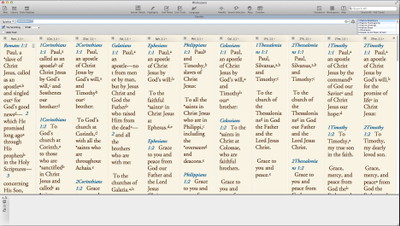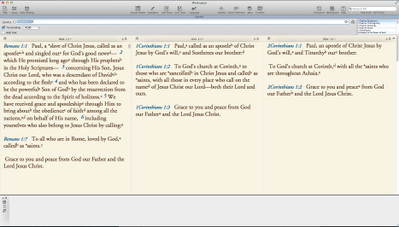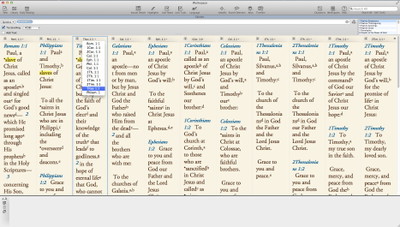In my last Throwback Thursday post, I mentioned my role in the design of the Parallels window. This window lets you view parallel passages side-by-side, such as parallels in the Synoptic Gospels or those found in Kings and Chronicles. Yet Accordance also includes Parallel databases covering less obvious parallel passages. For example, the Epistles parallel database lets you compare similar passages in the various New Testament epistles.
You can open the Epistles parallel from the Library or from the New pop-up menu of the Toolbar. When you do, the first “pericope”—that is, set of parallel passages—is automatically displayed. This first pericope just happens to be all of the Pauline Salutations, and it is fascinating to look at how Paul introduces himself in each of his epistles.
By default, the Parallels window will typically open with two or three panes. If there happen to be more than two or three parallel passages in a pericope, you’ll see two right-facing arrows on the right side of the parallel window directly beneath the list of pericopes. Just click on that to add another pane.

You can add as many panes as you have room for on the screen. On my 17-inch MacBook Pro I can view 11 parallel passages—all but two of the 13 epistles attributed to Paul. To see the passages from Titus and Philemon, I can simply view them in any of the existing 11 panes. A pop-up menu at the top of each pane lets you choose which passage you want displayed in that pane. You can also use these pop-up menus to change the order in which the passages are displayed. For example, if I wanted to group all the passages where Paul calls himself a “slave” together, I could change the second pane to Philippians and the third pane to Titus.
Viewing parallel parts of the epistles like this can reveal interesting things about the author’s situation, or his purpose for writing, or the nature of his audience. We might ask why, for example, Paul refers to himself as a “slave” in Romans, Philippians, and Titus but not in the other epistles. Or we might observe that Paul calls himself an apostle in all but four of the epistles (Philippians, 1 & 2 Thessalonians, and Philemon) and ask ourselves why those four are the exception to the rule. As for those that do use “apostle,” we might look at the ones where Paul adds to the usual formula. Why, for example, does he emphasize that his apostleship is “not from men” in Galatians or that he was “singled out for God’s good news” in Romans?
If you’re starting a study of one of the epistles, I’d recommend you spend a little time with the Epistles parallel. You’ll be surprised at the observations you can make by comparing one epistle with another.



